
CBOT Dec23 #corn reached 6-month lows Friday though is nearly identical to year-ago. Dec22 corn continued upward from here after the Ukraine invasion, topping $7/bu by April. Where is Dec23 headed now?
1hr
On this chart I replaced 2021 & 2020 with years with more similar price levels to now: 2011 & 2013. Very different paths taken from here.
Wheat price taking a big hit from precip on the way to help the drought stricken HRW crop, as mentioned yesterday:
More beneficial rain/snow out West
5 responses |
Started by metmike - Feb. 23, 2023, 11:25 p.m.
https://www.marketforum.com/forum/topic/93384/
These were the last ratings for Winter wheat at the end of last year:
https://www.marketforum.com/forum/topic/91204/
| Karen Braun@kannbwx A good portion of winter #wheat in the U.S. Plains - Kansas, Oklahoma, Texas, Colorado, Nebraska, South Dakota - is in poor or worse condition. Top grower Kansas is the worst at 43% poor/very poor. But look at drastic improvements vs last wk in other Plains states (Tex, OK, CO).  ++++++++++++++++++++++++++++++++ · From the good/excellent angle, #wheat in Montana, Colorado and Oklahoma improved last week, but Texas was marginal and Kansas worsened. Also don't overlook SRW producer Illinois, just 30% g/e. Crops around the country will need a good replenishment come spring.  | Dec. 1, 2022, 6:28 p.m. metmike |
Total precip from the just out 12z GEFS.
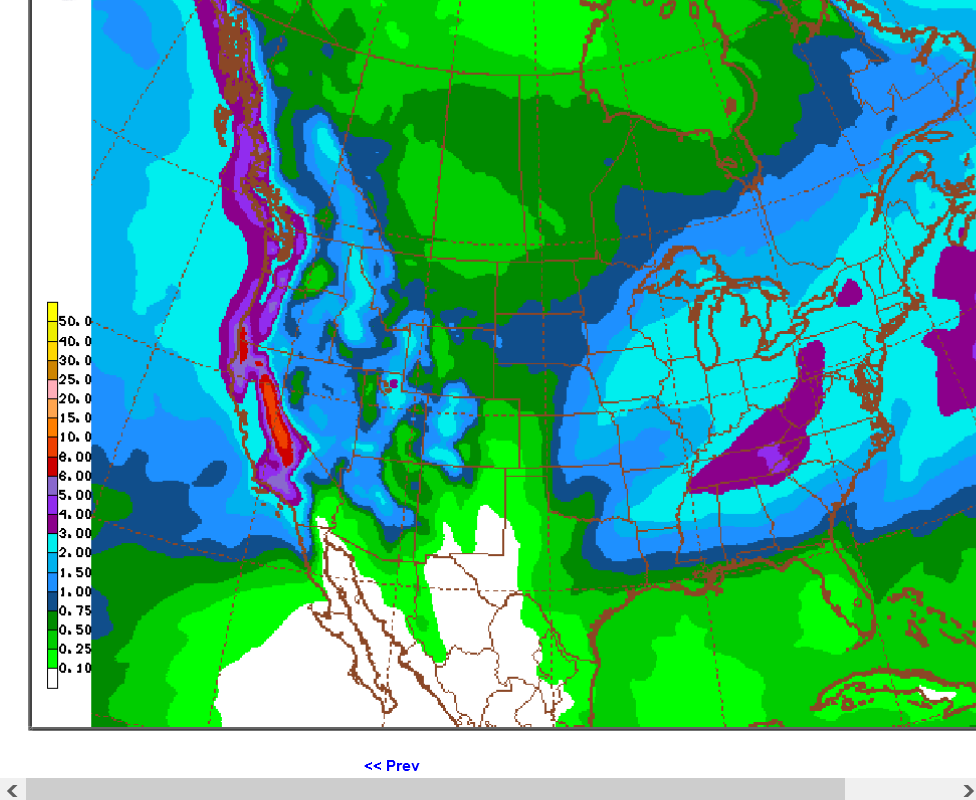
Total snow below
Soilmoisture anomaly:
These maps sometimes take a day to catch up to incorporate the latest data(the bottom map is only updated once a week).
https://www.cpc.ncep.noaa.gov/products/Soilmst_Monitoring/US/Soilmst/Soilmst.shtml#


The drought monitor is LONGER TERM moisture. We've been busting the drought in many places this Winter! The Plains are still Extremely dry. However, an El Nino on the way brings increasing chances to wipe out that drought too.
https://droughtmonitor.unl.edu/
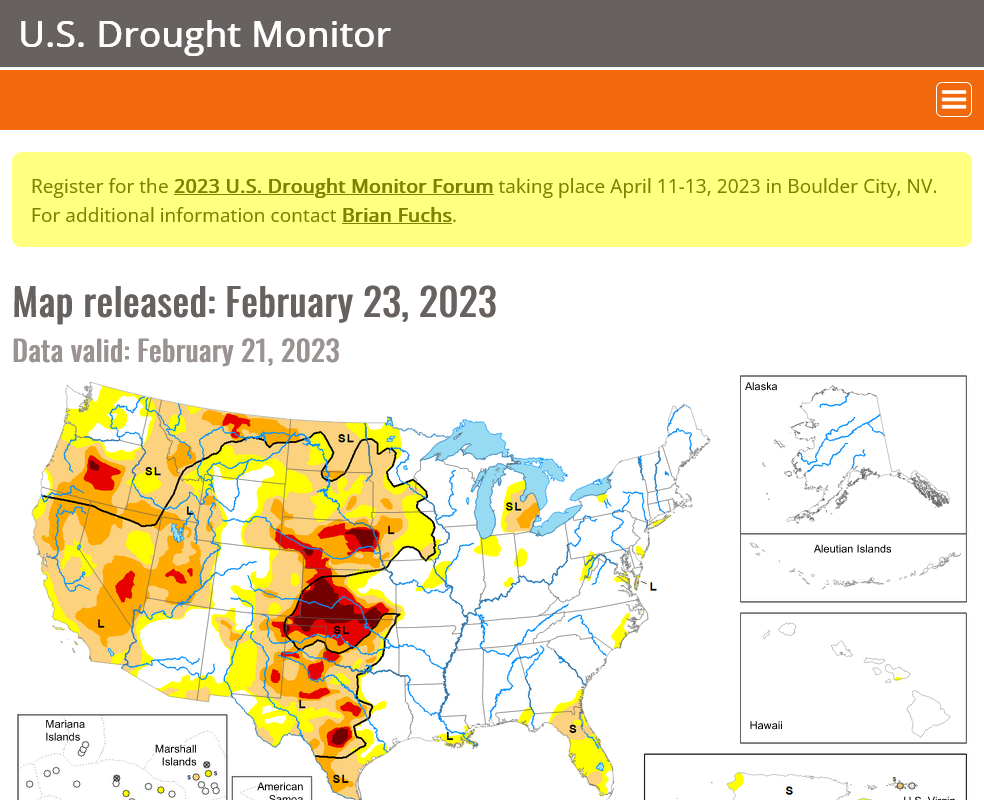
sorry met mike didnt see you had this wheat thread already started,,,also wheat getting hit on peace whispers...any level to bottom? 650?
no reason to be sorry, cc. We appreciate all your posts!
MetMike
Is it too late to "save" the winter wheat crop? (Any HR agronomists opine, please)
My work suggests daily and weekly (primary) cycle lows to be established this week in the wheats, perhaps half primary lows in corn. (Beans may have lows midMarch) (Oats at expiration?)
(Cautionary Note: I tend to be early on trades! NG living proof)
tjc,
Great question!
Deep roots and solid establishment ahead of Winter are a key for especially being able to withstand adversity during Winter and avoiding Winterkill.
In the absence of harsh Winter weather, a crop going dormant in very poor condition can avoid being killed and can recover after coming out of dormancy.
How much recovery depends on
1. How bad the crop was going dormant
2. How bad/good the Winter was
3. How favorable the Spring weather is
Harsh Winter weather on top of very poor conditions going dormant = DEAD (or not far from it) WHEAT plants coming out of dormancy.
I am not tuned into exactly what kind of Winter it's been for the S.Plains with regards to extreme cold other than moisture continued to be very scarce with very little snow to protect the crop.
Extremely dry and bare soils on top of a poor crop makes Winterkill much more likely with less extreme cold.
-5 deg. F is sort of the threshold but you can have repeated freeze/thaw cycles that are bad or extreme warmth that tries to coax wheat out of dormancy...........then a cold blast above -5 deg. F on top of wheat thats a bit more vulnerable.
So it's possible for the wheat plants to make an almost miraculous recovery(wheat is known as the crop that's toughest to kill).
The first crop ratings in the Spring will help tell us how wheat did over the Winter.
+++++++++
Here's the 2 week precip forecast. Much of this is coming up in the next 24 hours.
https://www.marketforum.com/forum/topic/83844/
Note that the heaviest stuff is just east of where its most needed. This is typical because Gulf moisture and dynamics don't come together until weather systems have crossed part of the Plains. There is often a well defined "dry line" west of which, we have very little moisture.
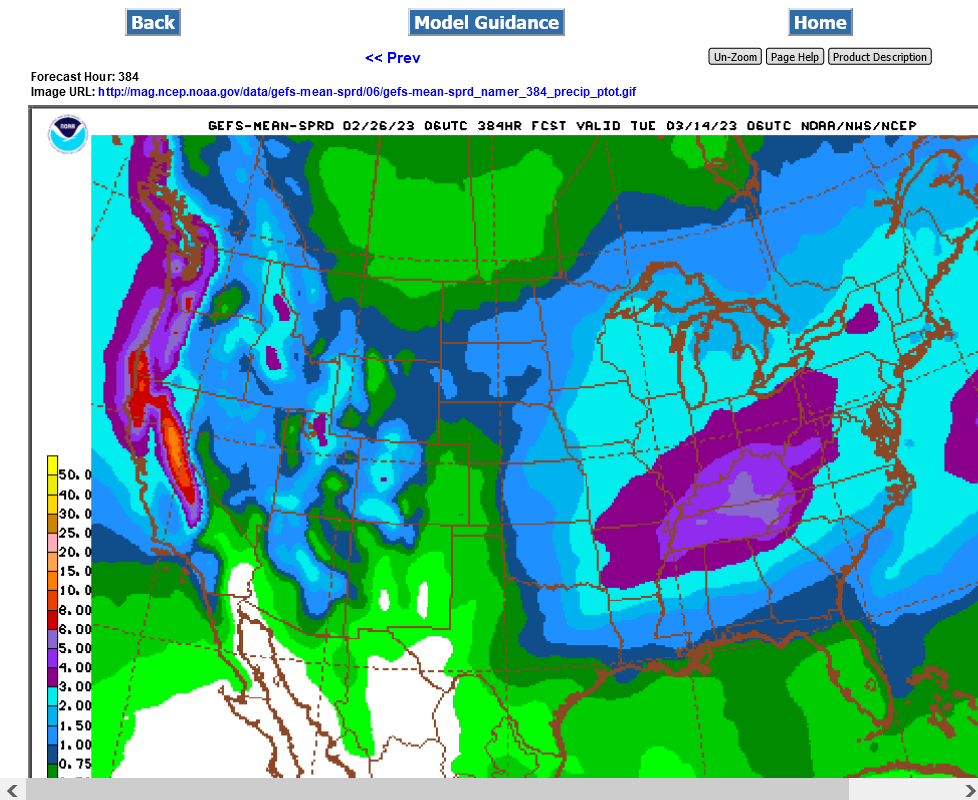
384 hour precip from the just out 0z GEFS:
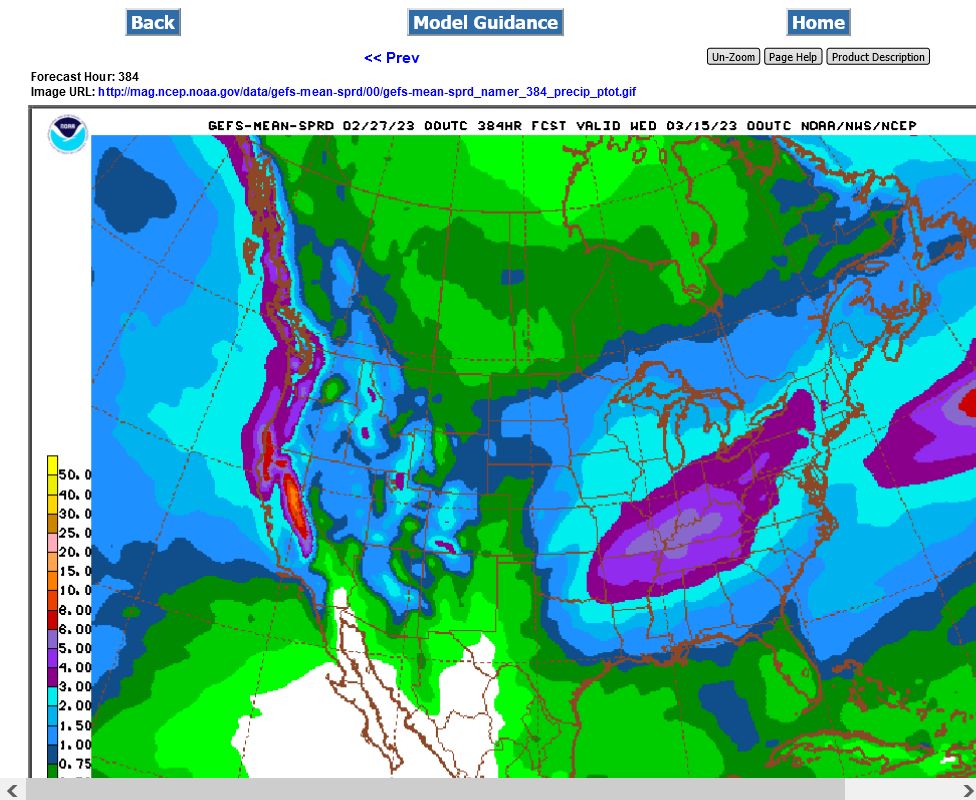
2 things about problems for wheat. The panhandle areas of Texas and Ok. have had dust storms. I think that this is a big problem on top of no moisture. Not sure but I think that area is rated poor?
My local area in SE to EC Indiana the crop seems to me to be coming out of dormancy. Tillering and green up seem to be taking place from the accumulation of warm weather, and soil temps.
Soil Temparature Maps | GreenCast | Syngenta (greencastonline.com)
The danger temperature is 12F at tillering. This stage is followed by jointing, and the danger temp rises to 24F.(purdue field guide page 46)
IF, IF this warm up continues we could have more frost risk later on.
First and last freeze/frost dates for Rushville, IN ,United States (davesgarden.com)
JMHO
IT'S GREENING UP NICELY IN MY NECCO-DA-WOODS, TOO...PLENTY OF MOISTURE. WITH 2" OF RAIN, LAST WEEK ~ ANOTHER INCH FOR TODAY & WE'RE HEADING FOR BELOW FREEZING, COME THURS. NIGHTS 29 - FRIDAYS 23 ~ SATURDAYS 21.
BUT.... UNLESS IT'S A HUGE TYPO OR... A HUGE MISCALCULATION ~ WE'RE HEADED FOR A MINI BLIZZARD ALL DAY, ON FRIDAY. 25 MPH WINDS & 8" OF SNOW... PROTECTING THE WHEAT?
Great points cutworm,
For wheat to be hurt from a Spring freeze, it almost always has to be mostly out of dormancy based on historical events.
As the wheat comes out of dormancy and becomes more vulnerable, the ability to generate enough cold to hurt the wheat dwindles EVEN FASTER than this.
However, after the wheat comes completely out of dormancy, it gets into some stages where it becomes hyper sensitive to cold.
Temps well down in the 20's can obliterate yields on wheat in the boot stage and that is still possible well into the Spring.
Wheat heading or flowering is the most susceptible.
The 2 years of noteworthy Spring wheat freezes were 1997 and 2007.
AGRICULTURAL EXPERIMENT STATION
AND
COOPERATIVE EXTENSION SERVICE
KANSAS STATE UNIVERSITY • MANHATTAN
SPRING FREEZE
INJURY
TO KANSAS WHEAT
https://bookstore.ksre.ksu.edu/pubs/c646.pdf
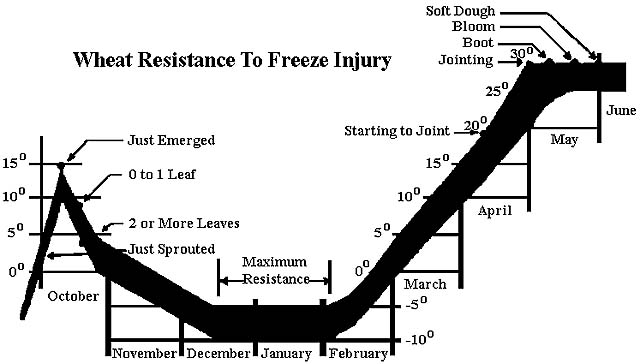
4/18/2007
https://www.agriculture.com/crops/wheat/production/Easter-freeze-aftermath_145-ar2498
"The wheat in Kentucky, Tennessee and the Missouri Bootheel is pretty much toast," writes Crop Talk poster wheatchris. "Any wheat drilled around mid-October has 80% to 90% of the heads dead, and it's too far along to regrow. It would have made 80 to 90 bushels [per acre], but now it's looking like 30 to 40 bushels [per acre] at best."
Elsewhere in the Midwest, it was the crop's delayed development that ended up being the "saving grace" for wheat in areas that analysts say will recover from the freeze.
"That was the saving grace for Ohio. Cold temperatures are most damaging to the crop when the wheat is at more advanced stages of development," Pierce Paul, an Ohio State University plant pathologist, says of the Ohio crop. "Some injury, seen as burning and discoloration of leaf tips, has occurred, and is more prevalent in fields with early-planted wheat. In addition, fields found in low-lying areas or planted with varieties that are more sensitive to cold temperatures tend to look worse."
Most-active CBOT #wheat futures hit new lows again Monday, trading just above $7/bushel mid/late session. The contract last traded below $7 on Sept. 22, 2021, though front-month wheat on Monday gained a $6-handle. Much different story from one year ago.
U.S. winter #wheat conditions, % good/excellent (vs month ago & year ago):
Kansas 19% (21% month ago, 25% last year)
Oklahoma 36% (17% ma, 11% ly)
Texas 19% (14% ma, 8% ly) Colorado 29% (38% ma, 21% ly)
Nebraska 19% (22% ma, 36% ly)
Montana 21% (16% ma, 21% ly)
U.S. winter #wheat, current % poor/very poor condition:
Kansas 51%
Oklahoma 41%
Texas 49%
Colorado 30%
Nebraska 40%
Montana 9%
CBOT December #corn, 2023 vs 2022. Average February price will be nearly the same for both years, but the journeys are very different.
Here's the same chart for new-crop November #soybeans, which traded notably lower this month versus Feb. 2022.
CPC's March 2023 outlook suggests much of the USA (except for the southeast) could be facing cooler-than-normal temperatures. Odds for above average precipitation prevail in the Ohio River Valley and in the west.
The danger temperature is 12F at tillering.
In my local area the wheat is starting to tiller.
I recorded 14 F last night
Is there damage???? to early to tell.
Thanks much cutworm!
Ill try to find out more on that.
vegetation was at least 10 days more advanced than average here, though we stayed above 20.
M,
What is the the prediction est. for the weather streams hitting the west coast to end? Does any of that precip help lake Powell?
Lake Powell is a losing proposition.
Too many people, too much that gets wasted from the natural dynamics of trying to store water there and massive sediment from rivers flowing into it are filling it and making it more and more shallow.
Evaporation in that location of the world is enormous, where some of the hottest air with extraordinarily low humidity exists for months.
It will never get refilled, even when robust Winter/Spring snow, melts in the Summer and runs into it, except when it's holding capacity shrinks to a small % of its original capacity.
Normal precip isn't enough.
Below average depletes it faster.
A Failed Solution
https://www.glencanyon.org/lake-powell-reservoir-a-failed-solution/
Images below
1. From 2017
2. From 2021
https://earthobservatory.nasa.gov/images/148861/lake-powell-reaches-new-low

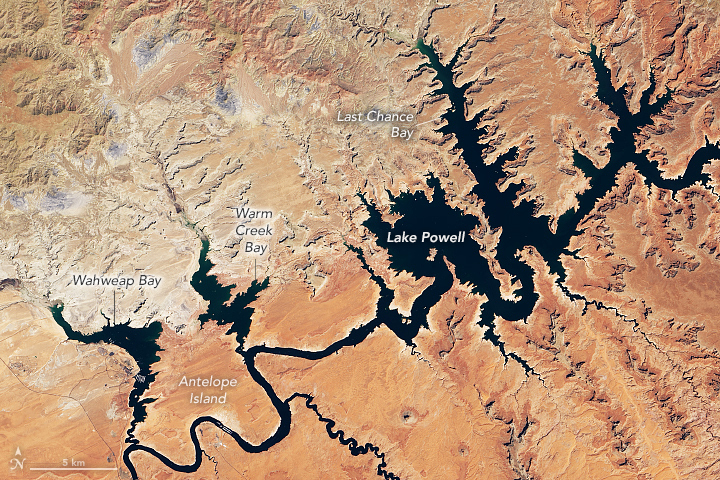
https://earthobservatory.nasa.gov/world-of-change/lake_powell.php
https://en.wikipedia.org/wiki/Lake_Powell
Lake Powell is an artificial reservoir on the Colorado River in Utah and Arizona, United States. It is a major vacation destination visited by approximately two million people every year. It is the second largest artificial reservoir by maximum water capacity in the United States behind Lake Mead, storing 24,322,000 acre-feet (3.0001×1010 m3) of water when full. However, Lake Mead has fallen below Lake Powell in size several times during the 21st century in terms of volume of water, depth and surface area.
Lake Powell was created by the flooding of Glen Canyon by the Glen Canyon Dam, which also led to the 1972 creation of Glen Canyon National Recreation Area, a popular summer destination of public land managed by the National Park Service. The reservoir is named for John Wesley Powell, a civil war veteran who explored the river via three wooden boats in 1869. It primarily lies in parts of Garfield, Kane, and San Juan counties in southern Utah, with a small portion in Coconino County in northern Arizona. The northern limits of the lake extend at least as far as the Hite Crossing Bridge.
Lake Powell is a water storage facility for the Upper Basin states of the Colorado River Compact (Colorado, Utah, Wyoming and New Mexico). The Compact specifies that the Upper Basin states are to provide a minimum annual flow of 7,500,000 acre-feet (9.3 km3) to the Lower Basin states (Arizona, Nevada, and California).
According to US Geological Survey and the Bureau of Reclamation report - In addition to water loss, Lake Powell faced an average annual loss in storage capacity of about 33,270 acre-feet, or 11 billion gallons, per year between 1963 and 2018 because of sediments flowing in from the Colorado and San Juan rivers, according to the report. Those sediments settle at the bottom of the reservoir and decrease the total amount of water the reservoir can hold.[2]
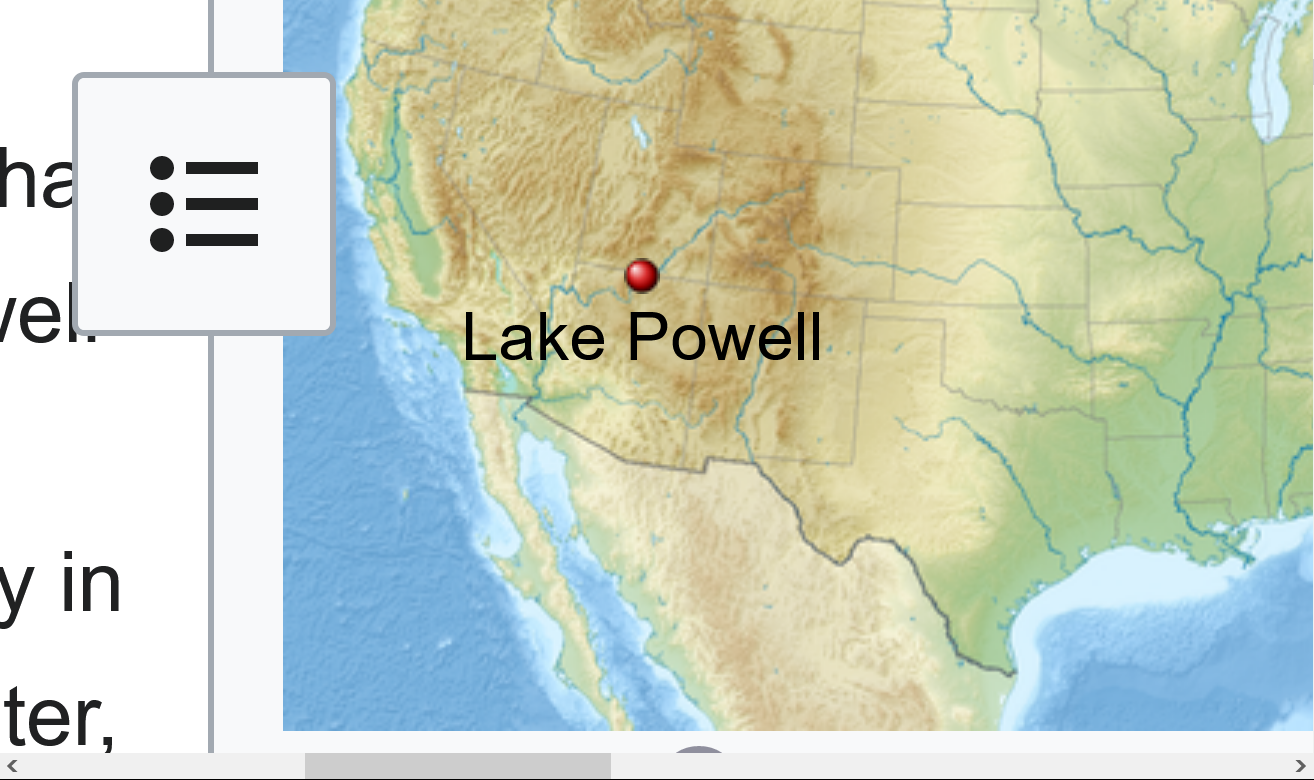
Highest snow pack in the last 10 years for the Southwest with more on the way.
This is astounding and just what the drought doctor ordered!
Why only reporting on how extreme and bad this is by media?
That doesn't sell!
This is mainly thanks to the global warming pattern/El Nino kicking in again in the Pacific after the pause caused by the La Nina(cold water in the tropical Pacific) which caused the drought....is over!
Climate change INCREASES precip!
https://www.wcc.nrcs.usda.gov/ftpref/data/water/wcs/gis/maps/west_swepctnormal_update.pdf
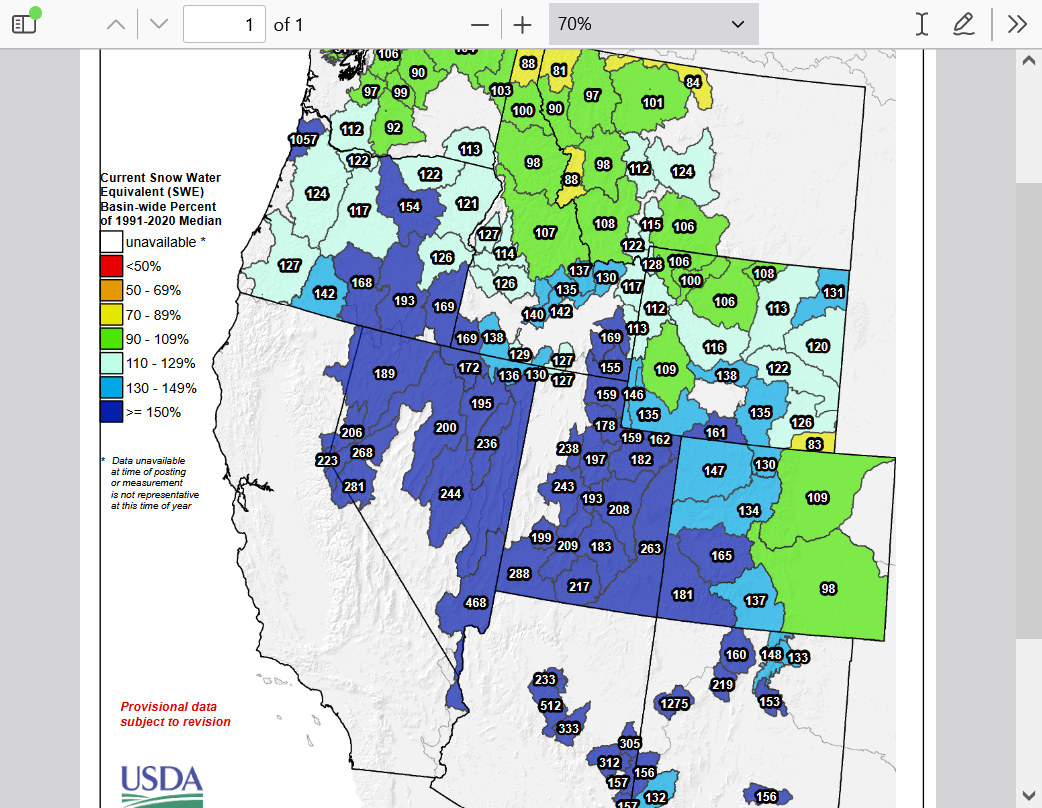
·
March 21: CBOT Nov #soybeans end at $12.96 per bushel, their first sub-$13 settle since Aug. 3. The contract has dropped more than 5% in the last two weeks. New-crop beans on this date a year ago settled at $14.90. Same date in 2021 = $12.16.
Zooming out to include many more years, it is clear that #wheat 37 cents above #corn is a historically narrow premium - usually it would track a bit higher, and that's true for both high- and low-supply years.
March 22: Most-active CBOT #wheat futures as of mid-session are trading around 37 cents per bushel above most-active #corn, wheat's narrowest premium to corn since mid-2021.
Somewhat unusual action this month in new-crop futures. CBOT Nov #soybeans had been making a run against Dec #corn early in March, ratio peaked at 2.46. But a big sell-off in beans in the last two weeks has dropped the bean/corn ratio to 2.32 by mid-session Wed.
Here's an example of a time that Nov #soybeans traded in oversold territory for a prolonged period (July 2014). Funds spent May-June 2014 selling what had been a hefty net long, flipping to a mild net short by mid-July. Both US stocks & acres were terribly bearish on June 30.
·
Relative Strength Index for CBOT Nov #soybeans has dropped below 20 as of mid-session Wednesday, indicating heavily oversold conditions. Beans have been trading at or below RSI 30 (standard "oversold" benchmark) for a week now.
·
It's only fair to show the whole year. The April 1, 2008 low ($10.45/bu) was not revisited until Sept. 30. The contract eventually went off the board at $8.78, but it had rallied to a high of $16.37 on July 3. Funds held a net long in #soybeans all the way through 2008.
CBOT November #soybeans, 2008 vs 2023 New-crop soybeans are down more than 5% this month. Compare that with March 2008, when Nov beans plunged 24%. The 2008 prices charted here aren't adjusted for inflation, but the point should easily come across anyway.
·
CBOT November #soybeans have closed lower for 13 consecutive sessions through Thursday, their longest losing streak within expiry year in at least 50 years. Cumulative losses are far from record (-8.8% in 13 sessions), though they're the biggest for March since 2008.
In fact, that record was set Tuesday (prior record was 10 straight sessions in June-July 2014). It seems like a pretty light record, but remember, the latest losses are far from the steepest ones (see June 2021, for example). #Soybeans moved further into oversold territory Thurs.
metmike:
I believe that the weather has been a huge factor in beans crashing and corn staying supported.
Early planting prospects look horrible in the Midwest.
1. Below normal temps keeping soils cold and above precip keeping them wet.
2. Big snow pack in the Upper Midwest that has to melt off before soils can even start to warm up and dry out.
3. Late planting years cause less corn acres(when optimal time runs out) and more bean acres.
4. Corn matures based on GDD's. Also, if you plant late, the season is shifted to later times when theres less solar energy to capture because of a lower sun angle during pollination and filling. Also increases chances for bad pollination weather and frost risk before maturity.
5. Beans follow day length. Optimal planting for full season beans is earlier in the year but June bean planting is still viable, especially with shorter season varieties vs planting corn that late.
6. La Nina is dead and the atmosphere is already acting like a full fledged El Nino which means a wet Spring.
cutworm, please chime in with anything I forgot to mention at the moment.
The dry weather is recent years from the La Nina meant timely planting in the Midwest.
The last year with MAJOR planting delays was 2019. Here's a great thread capturing the dynamics and thinking then:
Grains June 3
24 responses |
Started by metmike - June 3, 2019, 7:53 p.m.
The inverse in old-new crop CBOT #soybeans (May-Nov in this case) weakened to $1.55 per bushel on Friday with a stronger rally in the November contract. Nov snapped a record 13-day losing streak. The inverse is historically strong, but less so than at this point in 21 or 22.
CBOT #wheat on Friday finished 45.5 cents above CBOT #corn, a historically low premium but off the week's low of 30 cents - that was the narrowest wheat premium to corn since May-July 2021, and before that, mid-2013.
March 24: CBOT front-month #wheat futures end almost $1.60 per bushel below Kansas City wheat, Chicago's biggest discount since spring 2011. In fact, it's the second largest for any date (in more than 40 yrs) outside of a delivery period.
Large Brazilian crop now available.
Demand destruction
Another opinion below;
Jerry Gulke: Can the Prospective Plantings Report Change the Market Tide? | AgWeb
Thanks extremely much, cutworm! Great points.
I've not been tracking the grains as close as usual since the growing season ended in SA and didn't realize that corn also had a decent drop.
My comments always try to dial in weather thoughts and seeing all the grains dropping brings to mind the most powerful weather potential for this upcoming growing season from the La Nina being dead and the atmosphere being already in El Nino mode.
La Nina's correlate strongly with droughts and poor growing seasons. El NIno's with good growing season weather.
I'll try to start a new thread that discusses the good prospects for the upcoming growing season(though the planting season is likely going to be adverse because of already mentioned elements).
https://www.marketforum.com/forum/topic/83698/#83751
By metmike - April 27, 2022, 7:51 p.m.
metmike: These are the Summer disparities vs average for analog years(those with a similar La Nina condition to what we have currently).
Below we have the Summer temperature and precipitation anomalies for the United States in Summers following a Spring La Nina.
We can see warmer than normal temperatures over much of the western half of the country. Of note is a colder than the normal signal for the southeastern United States.

Precipitation-wise, we have a drier signal for a La Nina Summer over much of the north, central and western United States. More precipitation is hinted over the Ohio Valley and the northeastern United States, and also in the southeast.
Brazil large crop, was going to be an additional 900 mil. bu of beans. BUT Arg looks like they are down to 25 mmt.That really offset 900 mi bu from Brazil. They will SA produce more than last yr. BUT not the massive supply that could have been. Just as Corn broke to stir up demand at cheaper prices(China) beans will do the same.
Planting intentions are upon us now this week. Snow, wet, cold the next 2 weeks could start to become interesting
Thanks bcb!
The last planting delay year was the last one BEFORE this La Nina dried things out.
Now, the approaching El Nino has already kicked into the atmosphere and is wetting things up.
Planting delay years are almost impossible to trade compared to droughts but this has all the early indications of major planting delays.
Also of a wonderful growing season as the El Nino really kicks in and we resume global warming.
The correlation between global warming/El Nino's and really good growing seasons in the US is extremely powerful.
That only sounds strange because the false narratives about the climate crisis are flat out lies, when it comes to the US Cornbelt.